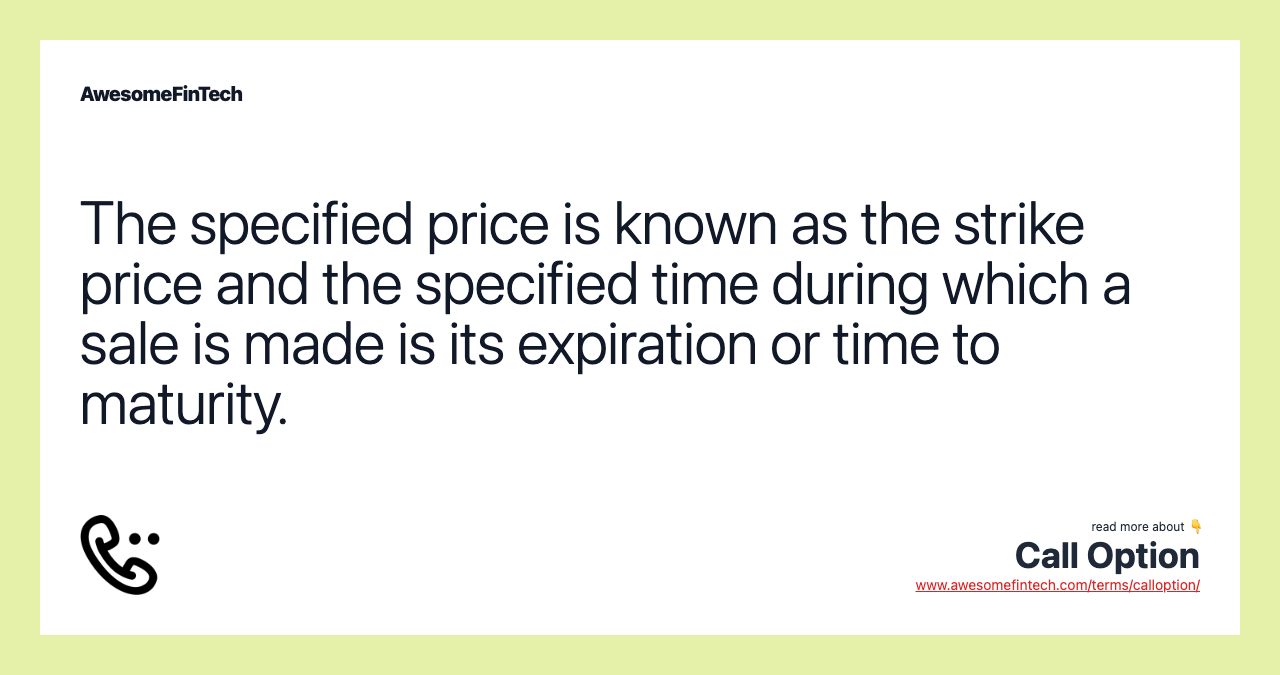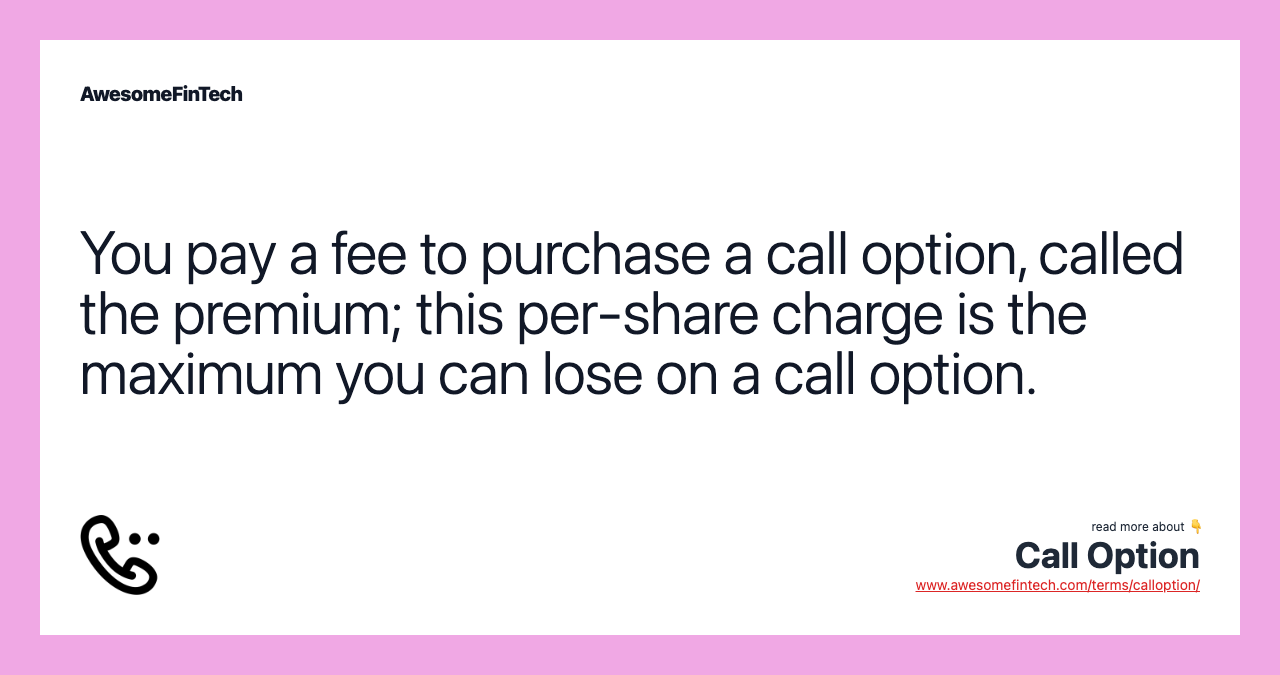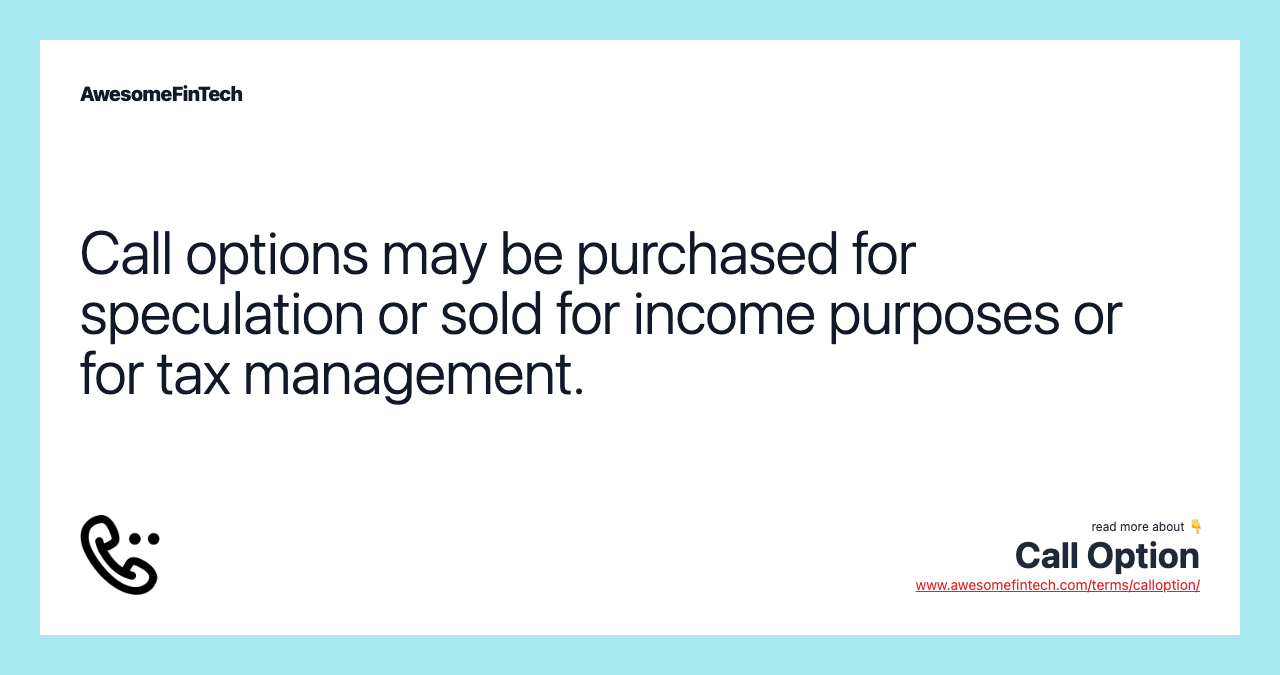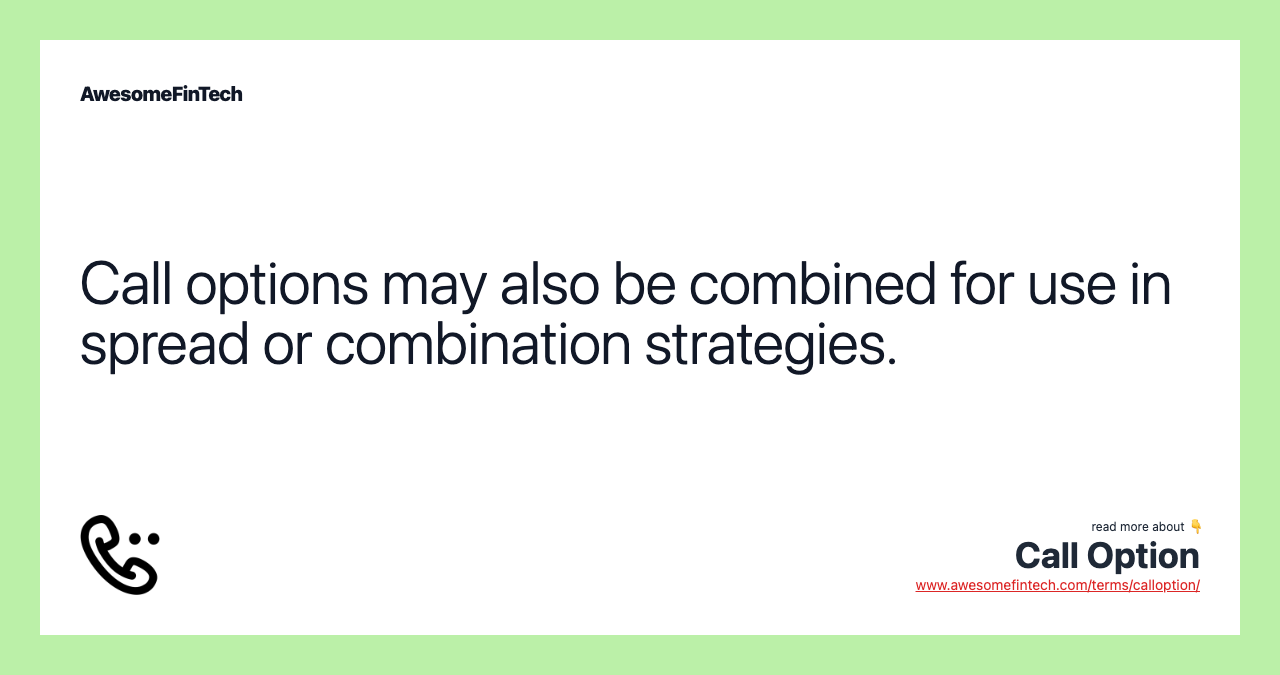Call Option
Table of Contents What Is a Call Option? Understanding Call Options Purposes of Call Options Example of a Call Option If the market price of the stock rises above the option’s strike price, the option holder can exercise their option, buying at the strike price and selling at the higher market price in order to lock in a profit. How Do Call Options Work? Why Would You Buy a Call Option? Is Buying a Call Bullish or Bearish? Call options are financial contracts that give the option buyer the right, but not the obligation, to buy a stock, bond, commodity, or other asset or instrument at a specified price within a specific time period. The call option buyer may hold the contract until the expiration date, at which point they can take delivery of the 100 shares of stock or sell the options contract at any point before the expiration date at the market price of the contract at that time. Call options are a type of derivative contract that gives the holder the right, but not the obligation, to purchase a specified number of shares at a predetermined price, known as the “strike price” of the option.

What Is a Call Option?
Call options are financial contracts that give the option buyer the right, but not the obligation, to buy a stock, bond, commodity, or other asset or instrument at a specified price within a specific time period. The stock, bond, or commodity is called the underlying asset. A call buyer profits when the underlying asset increases in price.
A call option may be contrasted with a put option, which gives the holder the right to sell the underlying asset at a specified price on or before expiration.





Understanding Call Options
Let's assume the underlying asset is stock. Call options give the holder the right to buy 100 shares of a company at a specific price, known as the strike price, up until a specified date, known as the expiration date.
For example, a single call option contract may give a holder the right to buy 100 shares of Apple stock at $100 up until the expiry date in three months. There are many expiration dates and strike prices for traders to choose from. As the value of Apple stock goes up, the price of the option contract goes up, and vice versa. The call option buyer may hold the contract until the expiration date, at which point they can take delivery of the 100 shares of stock or sell the options contract at any point before the expiration date at the market price of the contract at that time.
You pay a fee to purchase a call option, called the premium. It is the price paid for the rights that the call option provides. If at expiry the underlying asset is below the strike price, the call buyer loses the premium paid. This is the maximum loss.
If the underlying asset's current market price is above the strike price at expiry, the profit is the difference in prices, minus the premium. This sum is then multiplied by how many shares the option buyer controls.
For example, if Apple is trading at $110 at expiry, the option contract strike price is $100, and the options cost the buyer $2 per share, the profit is $110 - ($100 +$2) = $8. If the buyer bought one options contract, their profit equates to $800 ($8 x 100 shares); $1,600 if they bought two contracts ($8 x 200).
Now, if at expiry Apple is trading below $100, obviously the buyer won't exercise the option to buy the shares at $100 per, and it expires worthless. The buyer loses $2 per share, or $200, for each contract they bought — but that's all. That's the beauty of options: You're only out the premium if you decide not to play.
Image by Sabrina Jiang © Investopedia 2020
Purposes of Call Options
Call options are often used for three primary purposes: income generation, speculation, and tax management.
Important
There are several factors to keep in mind when it comes to selling call options. Be sure you fully understand an option contract's value and profitability when considering a trade, or else you risk the stock rallying too high.
Using Options for Income
Some investors use call options to generate income through a covered call strategy. This strategy involves owning an underlying stock while at the same time writing a call option, or giving someone else the right to buy your stock. The investor collects the option premium and hopes the option expires worthless (below strike price). This strategy generates additional income for the investor but can also limit profit potential if the underlying stock price rises sharply.
Covered calls work because if the stock rises above the strike price, the option buyer will exercise their right to buy the stock at the lower strike price. This means the option writer doesn't profit on the stock's movement above the strike price. The options writer's maximum profit on the option is the premium received.
Using Options for Speculation
Options contracts give buyers the opportunity to obtain significant exposure to a stock for a relatively small price. Used in isolation, they can provide significant gains if a stock rises. But they can also result in a 100% loss of the premium if the call option expires worthless due to the underlying stock price failing to move above the strike price. The benefit of buying call options is that risk is always capped at the premium paid for the option.
Investors may also buy and sell different call options simultaneously, creating a call spread. These will cap both the potential profit and loss from the strategy but are more cost-effective in some cases than a single call option, since the premium collected from one option's sale offsets the premium paid for the other.
Using Options for Tax Management
Investors sometimes use options to change portfolio allocations without actually buying or selling the underlying security.
For example, an investor may own 100 shares of XYZ stock and may be liable for a large unrealized capital gain. Not wanting to trigger a taxable event, shareholders may use options to reduce the exposure to the underlying security without actually selling it. While gains from call and put options are also taxable, their treatment by the IRS is more complex because of the multiple types and varieties of options. In the case above, the only cost to the shareholder for engaging in this strategy is the cost of the options contract itself.
While options profits usually will be classified as short-term capital gains, the method for calculating the tax liability will vary by the exact option strategy and holding period.
Real World Example of a Call Option
Suppose that Microsoft shares are trading at $108 per share. You own 100 shares of the stock and want to generate an income above and beyond the stock's dividend. You also believe that shares are unlikely to rise above $115.00 per share over the next month.
You take a look at the call options for the following month and see that there's a 115.00 call trading at $0.37 per contract. So, you sell one call option and collect the $37 premium ($0.37 x 100 shares), representing a roughly four percent annualized income.
If the stock rises above $115.00, the option buyer will exercise the option and you will have to deliver the 100 shares of stock at $115.00 per share. You still generated a profit of $7.00 per share, but you will have missed out on any upside above $115.00. If the stock doesn't rise above $115.00, you keep the shares and the $37 in premium income.
How Do Call Options Work?
Call options are a type of derivative contract that gives the holder the right, but not the obligation, to purchase a specified number of shares at a predetermined price, known as the “strike price” of the option. If the market price of the stock rises above the option’s strike price, the option holder can exercise their option, buying at the strike price and selling at the higher market price in order to lock in a profit.
Options only last for a limited period of time, however. If the market price does not rise above the strike price during that period, the options expire worthless.
Why Would You Buy a Call Option?
Investors will consider buying call options if they are optimistic — or “bullish” — about the prospects of its underlying shares. For these investors, call options might provide a more attractive way to speculate on the prospects of a company because of the leverage that they provide. After all, each options contract provides the opportunity to buy 100 shares of the company in question. For an investor who is confident that a company’s shares will rise, buying shares indirectly through call options can be an attractive way to increase their purchasing power.
Is Buying a Call Bullish or Bearish?
Buying calls is a bullish behavior because the buyer only profits if the price of the shares rises. Conversely, selling call options is a bearish behavior, because the seller profits if the shares do not rise. Whereas the profits of a call buyer are theoretically unlimited, the profits of a call seller are limited to the premium they receive when they sell the calls.
Related terms:
Bear Market : Phases & Examples
A bear market occurs when prices in the market fall by 20% or more. read more
Binomial Option Pricing Model
A binomial option pricing model is an options valuation method that uses an iterative procedure and allows for the node specification in a set period. read more
Black-Scholes Model
The Black-Scholes model is a mathematical equation used for pricing options contracts and other derivatives, using time and other variables. read more
Bond Option
A bond option is an option contract in which the underlying asset is a bond. In general, options are a derivative product allowing investors to speculate. read more
Bull Market : Characteristics & Examples
A bull market is a financial market in which prices are rising or are expected to rise. read more
Butterfly Spread
Butterfly spread is an options strategy combining bull and bear spreads, involving either four calls and/or puts, with fixed risk and capped profit. read more
Call Option
A call option is a contract that gives the option buyer the right to buy an underlying asset at a specified price within a specific time period. read more
Capital Gain
Capital gain refers to an increase in a capital asset's value and is considered to be realized when the asset is sold. read more
Commodity
A commodity is a basic good used in commerce that is interchangeable with other goods of the same type. read more
Covered Call
A covered call refers to a financial transaction in which the investor selling call options owns the equivalent amount of the underlying security. read more